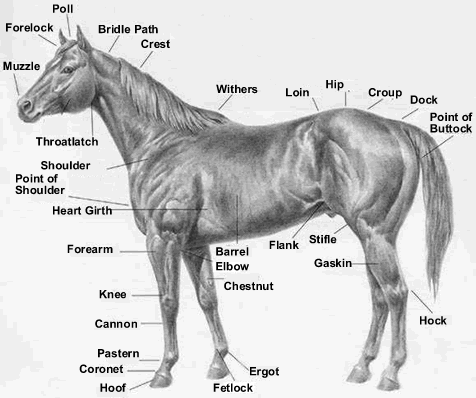By Bill Pressey
, of Thoroedge Equine Performance

‘Conformation is the blending of the various body parts, and how well they fit together visually and physically to create a running machine.’ - http://www.horsehats.com/Conformation.html
As the image above indicates; conformation can be further defined by various subjective opinions of the head, neck, shoulder, hip, legs, feet, walk, etc. More modern work has focused on equine biomechanics – or objective measures of many of these same factors. Gait analysis of 2yo in training quantifies this further by putting the horse in motion.
Horsemen hone these observational skills concerning what makes a runner over decades watching horses race, exercise, stand in their stalls, and parade around various auction rings worldwide.
BUT WHAT ABOUT THE INSIDE?
One of my New Year’s Resolutions for 2012 is to educate the thoroughbred world about the importance of internal conformation – how the equine lungs, heart, spleen, blood chemistry, enzymes, muscles, capillaries, mitochondria, etc. act in unison to define ‘class’ and athletic performance. You can’t see this stuff, and it doesn’t mean anything while a horse merely stands or walks – but put ‘em at a gallop and the resulting numbers tell much of the story.
I could stop here and go into detail about each of the aspects of internal conformation, but that misses the entire point – it’s not the heart, or lungs, or biomechanics, per se that define athleticism – it is the inter-related function of ALL systems during exercise that provides the most valuable insights.
We are no longer predicting potential based on pedigree or external opinions, we are measuring actual performance objectively through data analysis of workload vs intensity of metabolic effort. Just as any horseman can tell you the potential equine version of Michael Jordan from observing the chassis, when you look under the hood during exercise – one can gauge just how accurate that assessment is.
EXTERNAL VS INTERNAL HORSEMANSHIP
In writing this blog about conditioning, I am routinely told ‘all horses are treated as individuals’ when it comes to training, and I have no doubt this is partially true. Trainers observe their charges each morning, feel legs for heat, check out the feed tub, and decide whether or not a particular horse will walk, jog, gallop, or breeze on any given day. That is traditional horsemanship, it is external in nature and highly subjective – no numbers are present, only judgments.
Internal horsemanship accomplishes much of the same, but with one major difference: once the decision is made as to the type of exercise to undertake, internal horsemanship tells you precisely how far and how fast to go. If the last breeze was 4F in :51 and the 2min heart rate recovery was 115bpm – this time you can go either further or faster. Similarly, if the last gallop was a mile in 2:30 and the blood lactate level was 2.7 – this time you can go in 2:20 to the mile, or stretch out the 2:30 pace by an extra half mile and be assured you are giving him exactly what he needs to get better, and no more.
Remember, humans have opinions – but horses have the facts, and HALF of those facts are on the inside – a valuable source of feedback that can be objectively turned into a set of numbers to guide you towards optimal conditioning – maximizing fitness while minimizing injury.
Finally, please consider:
Horses with crooked legs can win races, so can horses with other conformational defects – hell one of my all-time favorites, Assault, was known as the ‘club-footed comet’, showing us that even the old saying ‘no foot, no horse’ isn’t always true as he galloped his way into the Triple Crown record books.
But, no horse with a maximal heart rate of 197bpm can ever win a race, nor can a horse who travels just 7 feet every time his heart beats during a gallop. Likewise, if you are a 22yo human standing 6’2 at 180lbs you may look like an athlete, but if your vertical jump is measured at just 17 inches – you are not going to be able to dunk a basketball.
Horses don’t have to catch, throw, or shoot any ball – they just have to run.
As much as the greats in our sport have been romanticized over the years, it’s not magic folks – these standouts have superior internal conformation that allows them to accomplish great workloads with lesser effort (a large heart is only one aspect) – and these characteristics are largely invisible to even the best horseman.
Now you have two horses with identical physiological underpinnings hook up in the stretch eyeball to eyeball, and one outfights the other, that is magic and well worthy of our respect and awe. Some things are indeed, indefinable – but that is the vast minority of cases.
http://thoroedge.wordpress.com/2012/01/02/new-years-resolution-learn-about-internal-conformation/




